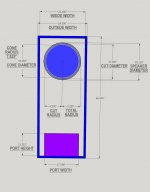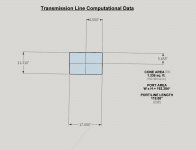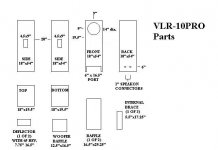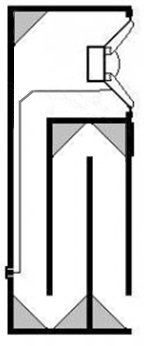I have been working on a TL enclosure design for a special project. I need a speaker that will clearly and cleanly produce 16Hz - 100 Hz for a virtual organ using digital samples. I only need one design that works, but so many designs that I see go to 20Hz and I need 16Hz because that is Low C on a 32' stop in the pedal. Once I have a working design, I can just reproduce the same design as needed. A driver has been suggested, a Dayton Audio PA460-8 and Dayton SPA1000 Plate amp. The enclosure that I have been working on is a standard TL, 2-baffle design. The dimensions are approx. ~24"W X ~30"D X ~60"H. The height isn't important as much as the footprint as floor space is a consideration. It can't be over 8' high though for locations that only have an 8' ceiling and it must be able to fit through a normal inside door (30"). I have been working with Microsoft Mathematics for the more complex math calculations, but because of medical problems, my ability to perform complex math is now a severe challenge. I have made a few designs based on the calculations I was told to use with Sketchup. Unfortunately, the outcome did not measure to the dimensions that my calculations said they needed to be. I have read many articles, watched many videos and most of them don't deal with an 18" driver...or if they do, they aren't a TL design and as I have seen, the TL design allows for much lower frequencies than most other designs. My goal is to produce from digital samples played through an organ, the effect that a real sizeable pipe organ has in sound and feel/experience. This needs to be at soft passages as well as full organ. I expect the room to shake as happens in a large stone church with 32' stops. I would appreciate any help or input, links, etc. for this project as I am doing it for my not-for-profit organization and at my cost from my disability income to be able to provide churches and other performance venues that cannot afford a pipe organ the experience of listening to one. Thank you, Steven
My first advise would be to use Hornresp for the calculations. A small learning curve for just the basics that you'll need and no more mathematics 
However, before everybody is suggesting drivers like the TC Sounds LMS 5400, it is good to know what your budget is.
Best regards Johan
That driver is about as far, from what I would suggest to use, as you can get. It's not a bad driver but not meant for your specific goals at all. Also, a driver that is nearer your goals will also like a lot more power.A driver has been suggested, a Dayton Audio PA460-8 and Dayton SPA1000 Plate amp
However, before everybody is suggesting drivers like the TC Sounds LMS 5400, it is good to know what your budget is.
Best regards Johan
16-100Hz, loud, is no small challenge. Simply slapping a PA 18" in a TL won't do what you're after. A single 18" can thump pretty hard 40Hz and upwards in smaller venues, but if you want to go low, you need to think bigger.
If it was mine, I'd grab 16x 12" car subwoofers. Organise them 8 high, 2 wide, sealed box as big as you can go, and dump several kilowatts in there. A pair of NU6000DSP amps would do it.
When it comes to VLF, there's no replacement for displacement.
Gotta say, though, that it's not gonna be cheap.
You might find a full-sized front-loaded horn will do the job. Those need to be huge to work down low, but plywood is cheaper than a bunch of drivers.
Chris
If it was mine, I'd grab 16x 12" car subwoofers. Organise them 8 high, 2 wide, sealed box as big as you can go, and dump several kilowatts in there. A pair of NU6000DSP amps would do it.
When it comes to VLF, there's no replacement for displacement.
Gotta say, though, that it's not gonna be cheap.
You might find a full-sized front-loaded horn will do the job. Those need to be huge to work down low, but plywood is cheaper than a bunch of drivers.
Chris
I think you need to look at very large excursion drivers, like the CSS 12" to make this work. My friend Pete did a tapped horn for a church in Salem that goes down to 20 hz but tapped horns only manage two octaves, as far as I know, and you need three or four, so the TL is a logical choice. Amplifier power is a must.
Maybe Brian Steele will chime in...
Maybe Brian Steele will chime in...
Steven,I have been working on a TL enclosure design for a special project. I need a speaker that will clearly and cleanly produce 16Hz - 100 Hz for a virtual organ using digital samples. I only need one design that works, but so many designs that I see go to 20Hz and I need 16Hz because that is Low C on a 32' stop in the pedal.
I expect the room to shake as happens in a large stone church with 32' stops. I would appreciate any help or input, links, etc. for this project as I am doing it for my not-for-profit organization and at my cost from my disability income to be able to provide churches and other performance venues that cannot afford a pipe organ the experience of listening to one. Thank you, Steven
TL is not the only way to go low and loud.
Data Bass compares many designs that put out some serious level down low (no TL as far as I can remember):
Data-Bass
The DTS-10 is a proven, cost-effective design, capable of nearly 120dB at 16 Hz with very low distortion using just two 12" drivers.
100 Hz is the very top of it's usable response, an unusually wide range for a tapped horn, and exceeding the sensitivity of a TL by a good margin.
Art
Last edited:
Drawing or sketch of what you have planned?
dave
Hear is one of several designs I have tried, but the line length and the overall size didn't work, even though I thought I was correctly following the parameters I needed to follow and got the correct. I can show you the figures I used (Using the PA460-8 as that is what I told had the correct values). I know that the "Q" values were an important factor in choosing that driver, the Qms and Qts needed to be low. I only have a rudimentary knowledge of what each value. I attached a couple of files that show basically what I came up with and followed. Here is the information I figured out. These are more or less notes to me. I hope this is what you requested. Thank you. Steven
Attachments
Drawing or sketch of what you have planned?
dave
Here are examples of what I was going to use...the Seismic Audio, New Madrid 18" woofer, but I was told the Qms and Qes were to high and so it was recommended that I use the Dayton Audio PA460-8 18" driver. I have attached some files that show you the plans with some calculations and also some attachments were information that I came up with and followed to try to re-design the TL enclosure to reflect that actual numbers I was after, but did something wrong and the end result was not correct in line length or port area for some reason. I have also added files that show a successful installation where the owner/builder says that the addition of the TL speaker made all of the difference in getting the "room shaking, chest pressure" that he was looking for. I am used to pipe organs (as is the user/builder of the system I am showing, so we know what the end result should sound and feel like. His expertise is more in Theatre organs and mine is in Classical organs and what I am building will be two virtual organs, one classical and one theatre, but sharing the same sound system (at least in the beginning to save money as I am disabled and have limited funds, so it doesn't stop me, but it takes a lot longer for things to be completed. I hope that some of this will make since as I am totally out of my realm (i.e. high-end audio design that uses complex math and physics). Ever since my stroke, my brain doesn't deal well with that kind of thing, plus, math was never my strong suit. I am a builder, so I can build a pipe organ and have head hundreds of them of varying sizes. I know what it is like to be in a large church/cathedral and hear a large organ with a good specification and several 32' ranks. There is no mistaking that feeling or sound. With modern sampling technology, it is now possible to reproduce that sound (IF you have a good enough audio system). Sorry to go on, but I tend to over explain things, or so I have been told. I hope I attach the files correctly, as I am not use to the Yahoo style of list forum format. Please let me know if you need more and I will see if I have it. I can give you audio samples of what I need this to be able to do, but you will need a system that will reproduce these very low frequencies from very low volume to very loud at full organ. The intensity of the pipe making the sound doesn't change. It can't be turned down like you can a stereo, you change volume by changing the registration of the organ. Thank you, Steven
Attachments
-
Audio Configuration.pdf318.1 KB · Views: 88
-
DAYTON AUDIO SPEAKER DETAILS - EDITED.pdf892.8 KB · Views: 120
-
NEEDED PARAMETERS FOR TL ENCLOSURE - EDITED.pdf204.9 KB · Views: 43
-
New Transmission Line Sub for the Pedal chamber.pdf349.1 KB · Views: 85
-
 SLIDE 2.jpg278.7 KB · Views: 797
SLIDE 2.jpg278.7 KB · Views: 797 -
 TL Computational Date - Slide 1.jpg93.1 KB · Views: 773
TL Computational Date - Slide 1.jpg93.1 KB · Views: 773 -
This is what I WAS going to use.pdf593 KB · Views: 92
The Dayton PA460 doesn't seem like a good match for a 16 Hz TL. The specs suggest that it will be a lot happier in a box tuned to around 38 Hz, and its limited Xmax is going to impact SPL capability at low frequencies anyway.
Specs you need to look for:
1. Fs around 16 Hz
2. Qts around 0.4
3. Xmax fairly high (12mm or above)
4. Low Le
16 Hz is going to be quite a challenge, and frankly I like the idea of going sealed with EQ and lots of drivers, rather than a higher-order system, to achieve it.
If you're set on a TL, the Dayton RSS460 (not the PA460 - that's a completely different driver), might do it, or at least get close.
Specs you need to look for:
1. Fs around 16 Hz
2. Qts around 0.4
3. Xmax fairly high (12mm or above)
4. Low Le
16 Hz is going to be quite a challenge, and frankly I like the idea of going sealed with EQ and lots of drivers, rather than a higher-order system, to achieve it.
If you're set on a TL, the Dayton RSS460 (not the PA460 - that's a completely different driver), might do it, or at least get close.
but did something wrong and the end result was not correct in line length or port area for some reason
From the info provided you are using next to useless Classic design techniques (for instance, cone area has nothing to do with proper design, and you are not taking advantage of driver offset are 2 clues).
With classic design you might luck onto an optimal design 10% of the time.
Time to forget everything you think you know and start reading. Start here Quarter Wavelength Loudspeaker Design
dave
It needs to fit through 30" doorways. Is it supposed to be portable?
Perhaps something in a tapped taper that can absorb lots of power. Shorter for bass extension and just dump a few kw into it.
Pipe organ tones are near enough sinusoidal and im guessing group delay wont be an issue.
Perhaps something in a tapped taper that can absorb lots of power. Shorter for bass extension and just dump a few kw into it.
Pipe organ tones are near enough sinusoidal and im guessing group delay wont be an issue.
Specs you need to look for:
1. Fs around 16 Hz
Does a Voigt pipe or TL lower driver resonance compared to free-air?
I think OP - who builds organs - is thinking of organ pipes and historic (and wonderful) TL boxes (like the Voigt that I'm also working on now). That is different than the "modern" TL theory that planet10 endorses (including concern about offsets) which is a kind of mass-loaded BR hiding in the folds. That is not a criticism of planet10, just pointing out a difference.
B.
Last edited:
I think OP - who builds organs - is thinking of organ pipes and historic (and wonderful) TL boxes (like the Vogt that I'm also working on now). That is different than the "modern" TL theory that planet10 endorses (including concern about offsets) which is a kind of mass-loaded BR hiding in the folds. That is not a criticism of planet10, just pointing out a difference.
The Voight Pipe alignment includes the use of an offset, and for the same reason that it's used in "modern" TL design.
Does a Vogt pipe or TL lower driver resonance compared to free-air?
... Makes no sense.
Fs is inherent to the driver.
You can tune a TL/Voigt pipe/whatever to whatever frequency you choose. The T/S parameters of the driver(s) in question will determine the frequency response.
Chris
Voigt Pipe/TL Question
I haven't been able to see detailed plans for the "pipe" design...Does it need to have baffles like a standard TL enclosure? Also, does the pipe have to be straight, or can it have curves/"Us" in it? I am asking because one picture that I saw was clearly about 12' tall and this has to fit under an 8' ceiling and fit through a normal inside door (30"). I almost forgot, most pipe designs use 2 drivers, is that part of that style of enclosure, or can you use a single driver? Thank you, Steven
I haven't been able to see detailed plans for the "pipe" design...Does it need to have baffles like a standard TL enclosure? Also, does the pipe have to be straight, or can it have curves/"Us" in it? I am asking because one picture that I saw was clearly about 12' tall and this has to fit under an 8' ceiling and fit through a normal inside door (30"). I almost forgot, most pipe designs use 2 drivers, is that part of that style of enclosure, or can you use a single driver? Thank you, Steven
- Status
- This old topic is closed. If you want to reopen this topic, contact a moderator using the "Report Post" button.
- Home
- Loudspeakers
- Subwoofers
- 16 Hz 18" TL enclosure design

